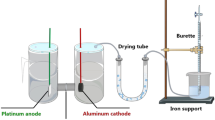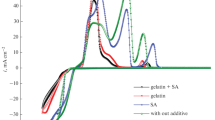Abstract
Context
Electroplated zinc layers have shown excellent corrosion resistance, especially those are stable in the atmosphere after the passivation, and therefore zinc electroplating is widely used in various fields such has mechanical, vehicle, construction, and ironware industries.
Benzalacetone (BA) was reported as brighteners for zinc deposition, while polyoxyethylene nonylphenylether (NP) was used as levelers or carriers for zinc electroplating. Sodium benzoate (SB) and dispersant NNO cooperatively act as auxiliary additives.
Quantum chemical parameters (QCPs) of four additives were calculated by using DFT, and MD simulations were performed. By comparing binding energies of four additives (benzalacetone (BA), sodium benzoate (SB), polyoxyethylene nonylphenylether (NP) and dispersant NNO), with Zn (001) surface, BA has the lowest binding energy, which is due to the lowest hardness parameter, and NNO has the highest binding energy, which is due to the highest dipole moment despite its small hardness parameter.
Methods
For DFT calculation, NWChem was employed, which uses the Gaussian basis set. The B3LYP functional was used for exchange-correlation interaction between electrons, and the 6-311G+ (d,p) basis sets were used for all the atoms. Solvation effect was considered by using COSMO (COnductor-like Screening MOdel), in which the dielectric constant of solvent was set to 78.54 of water. For dispersion correction, DFT-D method of Tkatchenko and Scheffler (TS) was used.
MD simulations were performed by using GULP (General Utility Lattice Program) code with Dreiding forcefield and atomic Hirshfeld charges from DFT calculations. MD simulations were performed on the conditions of NVT ensemble with a step of 1 fs and simulation time of 500 ps at 298 K and 323 K. To consider solvation effect, 1,000 water molecules were inserted into the box.









Similar content being viewed by others
Data availability
All data generated or analysed during this study are included in this published article.
Code availability
All the calculations were performed by using NWChem and GULP code.
References
Kanani N (2006) Electroplating: basic principles, processes and practice. Elsevier, Kidlington
Hoogendoorn BW, Parra M, Capezza AJ, Li Y, Forsberg K, Xiao X, Olsson RT (2022) Cellulose-assisted electrodeposition of zinc for morphological control in battery metal recycling. Mater Adv 3:5304–5314
Nayana KO, Venkatesha TV (2011) Synergistic effects of additives on morphology, texture and discharge mechanism of zinc during electrodeposition. J Electroanal Chem 663:98–107
Muralidhara HB, ArthobaNaik Y (2008) Electrochemical deposition of nanocrystalline zinc on steel substrate from acid zincate bath. Surf Coat Technol 202:3403–12
Yu JX, Chen YY, Yang HX (1999) The influences of organic additives on zinc electrocrystallization. J Electrochem Soc 146:1789–1793
Hsieh JC, Hu CC, Lee TC (2008) The synergistic effects of additives on improving the electroplating of zinc under high current densities. J Electrochem Soc 155:D675–D681
Mirkova L, Maurin G, Krastev I, Tsvetkova C (2001) Hydrogen evolution and permeation into steel during zinc electroplating: effect of organic additives. J Applied Electrochem 31:647–654
Kavitha B, Santhosh P, Renukadevi M, Kalpana A, Shakkthivel P, Vasudevan T (2006) Role of organic additives on zinc plating. Surf Coat Technol 201:3438–3442
Kaneko N, Shinohara N, Nezu H (1993) Effects of aromatic carbonyl compounds on the electrocrystallization of zinc from acid sulfate solutions. Electrochim Acta 38:1351–1357
Wang C, Zhang J, Yang P, An M (2013) Electrochemical behaviors of janus green b in through-hole copper elec-troplating: an insight by experiment and density functional theory calculation using safranine t as a comparison. Electrochim Acta 92:356–364
Lai Z, Wang S, Wang C, Hong Y, Zhou G, Chen Y, He W, Peng Y, Xiao D (2018) A comparison of typical additives for copper electroplating based on theoretical computation. Comp Mat Sci 147:95–102
Lai Z, Wang S, Wang C, Hong Y, Chen Y, Zhang H, Zhou G, He W, Ai K, Peng Y (2018) Computational analysis and experimental evidence of two typical levelers for acid cop per electroplating. Electrochim Acta 273:318–326
Valiev M, Bylaska EJ, Govind N, Kowalski K, Straatsma TP, Van Dam HJJ, Wang D, Nieplocha J, Apra E, Windus TL, de Jong WA (2010) Nwchem: a comprehensive scalable open-source solution for large scale molecular simulations. Comput Phys Commun 181(9):1477–1489
Becke AD (1993) Density-functional thermochemistry. iii. the role of exact exchange. J Chem Phys 98:5648–52
Klamt A, Schuurmann G (1993) Cosmo: a new approach to dielectric screening in solvents with explicit expressions for the screening energy and its gradient. J Chem Soc Perkin Trans 2:799
Delly B (2006) The conductor-like screening model for polymers and surfaces. Mol Simul 32:117–123
Tkatchenko A, Scheffler M (2009) Phys Rev Lett 102:073005
Parr RG, Pearson RG (1983) J Am Chem Soc 105:26
Parr RG, Szentpaly LV, Liu S (1999) J Am Chem Soc 121:9
Hua LM, Dong SY, Li QL, Feng JL, Pi YQ, Liu ML, Sun JY, Sun JH (2015) Facile synthesis of BiOF/Bi2O3/reduced graphene oxide photocatalyst with highly efficient and stable natural sunlight photocatalytic performance. J Alloys Compd 633:256–264
Kirkpatrick S, Gelatt CD, Vecchi MP (1983) Optimization by simulated annealing. Science 220:671–680
Gale JD, Rohl AL (2003) The general utility lattice program (gulp). Mol Simul 29:291341
Mayo SL, Olafson BD, Goddard WA (1990) Dreiding: a generic forcefield. J Phys Chem 94:8897–909
Hirshfeld FL (1977) Theor Chim Acta B 44:129
Gece G (2008) Corros Sci 50:11
Geerlings P, De Proft F (2002) Int J Mol Sci 3:4
Obi-Egbedi NO, Obot IB, El-Khaiary MI (2011) J Mol Struct 1002:1–3
Li X, Deng S, Fu H, Li T (2009) Electrochim Acta 54:16
Acknowledgements
The simulation has been carried out on the HP Blade System c7000 (HP BL460c) that is owned and managed by Faculty of Materials Science, Kim Il Sung University.
Author information
Authors and Affiliations
Contributions
The first draft of the manuscript was written by Song-Kyun Ri and all authors commented on previous versions of the manuscript.
Corresponding authors
Ethics declarations
Competing interests
The authors declare no competing interests.
Conflict of interest
The authors declare that they have no conflict of interest.
Additional information
Publisher's note
Springer Nature remains neutral with regard to jurisdictional claims in published maps and institutional affiliations.
Rights and permissions
Springer Nature or its licensor (e.g. a society or other partner) holds exclusive rights to this article under a publishing agreement with the author(s) or other rightsholder(s); author self-archiving of the accepted manuscript version of this article is solely governed by the terms of such publishing agreement and applicable law.
About this article
Cite this article
Ri, SK., Kang, JH., Pak, MC. et al. Theoretical investigation of adsorption characteristics of typical additives for zinc electroplating. J Mol Model 29, 296 (2023). https://doi.org/10.1007/s00894-023-05686-2
Received:
Accepted:
Published:
DOI: https://doi.org/10.1007/s00894-023-05686-2




